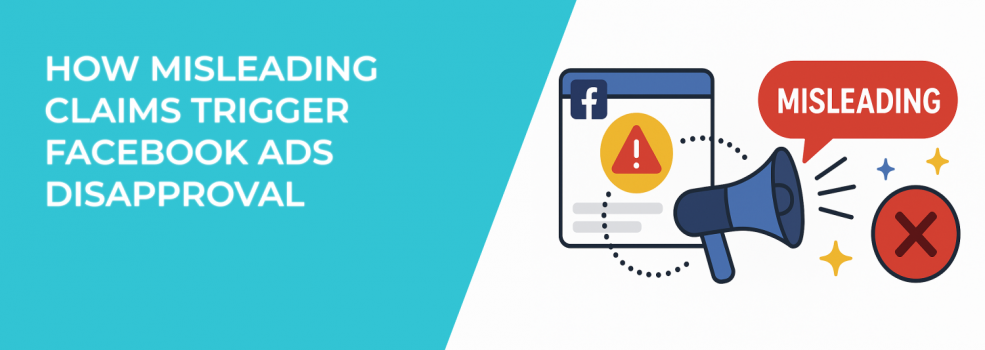If your Facebook ad got disapproved and you saw “misleading claims” in the policy notice, you’re not alone. Many marketers and business owners — even experienced ones — get caught off guard by Meta’s strict content rules.
What counts as misleading isn’t always obvious. In fact, some of the most common ad copy tactics are exactly what can get your ad rejected. And if your landing page includes similar language? You’re in even more trouble.
Let’s explore how this happens, what Facebook is really looking for, and how to fix or prevent rejections before they cost you results.
What Meta Flags as “Misleading” — And Why It’s Stricter Than You Think
Meta’s Ad Standards prohibit anything that makes deceptive, exaggerated, or unverifiable claims. That includes both your actual wording and the implied message you’re sending.
Here are common phrases and ad formats that often get flagged:
-
Unrealistic claims or timelines.
Example: “Make $10K per month with this side hustle — no experience needed.” -
Absolute promises of results.
Example: “We guarantee you’ll book 5 client calls a week.” -
Sensational, vague, or emotionally charged phrasing.
Example: “This one secret changed my life — doctors don’t want you to know it.” -
Before-and-after imagery.
These are banned across health, fitness, skincare, and weight loss ads.
Even if your intention is harmless, these types of claims are considered high-risk. They raise red flags with Meta’s automated review tools and create the impression that the ad might mislead users. The more emotionally charged or exaggerated the language, the higher the chance of rejection.
Your Landing Page Might Be Getting You Flagged, Too
Even if your ad copy seems safe, Facebook also reviews where your ad sends users after the click. This means your landing page can be the reason for disapproval.
Pages that include fake urgency, unrealistic promises, exaggerated testimonials, or suspicious formatting (like tiny disclaimers or hard-to-find terms) may trigger rejection.
Watch out for:
-
Overly pushy copy like “Only 2 left — act now!”
-
Misaligned headlines that don’t reflect the ad’s message.
-
Fine print that contradicts the main claim.
-
Testimonials that aren’t backed by data or context.
Landing page quality matters just as much as ad copy. Even if your ad makes it through initial approval, a misleading or inconsistent page can get your campaign flagged later. Meta wants the entire user experience — from click to conversion — to be transparent and trustworthy.
For more guidance, Understanding Facebook Ad Statuses: Common Issues and How to Fix Them can help you interpret those vague rejection messages and take the right steps to recover.
What Facebook Is Really Protecting
Meta doesn’t want its platforms to become flooded with spammy, scammy, or overpromising messages. Why? Because it erodes user trust — which affects how long people stay on the app, how often they click ads, and whether they feel safe engaging with businesses.
This is why misleading ads — even ones that seem harmless — get blocked aggressively. They can make users feel like they’re being tricked, pressured, or targeted unfairly.
If your campaign starts out strong and suddenly drops to zero delivery, it might not be your audience or budget. It could be Meta’s system quietly suppressing your ad due to credibility concerns.
How to Write Facebook Ads That Convert — Without Getting Rejected
Writing ad copy that’s both persuasive and policy-safe takes skill. But it’s not about watering down your message — it’s about clear communication that builds trust.
Here are proven ways to stay compliant while still driving action:
-
Be clear about who the result applies to.
Avoid: “Double your income in 30 days.”
Try: “Discover tools used by consultants to grow revenue — results vary by experience and niche.” -
Replace hype with specificity.
Avoid: “This trick will change everything.”
Try: “This 3-step system helped reduce abandoned carts by 22% for new e-commerce stores.” -
Use disclaimers the right way.
Avoid: burying “results not typical” in tiny text.
Instead: integrate honest disclaimers into your main message.
Example: “Most users see results within 2–4 weeks. Individual results vary.” -
Focus on benefits, not guarantees.
Avoid: “Get leads fast — or your money back!”
Try: “Tested lead-gen strategies designed for fast-growing local businesses.”
These changes help your ad feel trustworthy while still highlighting your offer. They're also easier to defend in a manual review if needed. For more examples and writing techniques, explore Crafting Compelling Facebook Ads Copy That Converts.
What to Do If Your Facebook Ad Gets Disapproved for “Misleading Claims”
Disapproval doesn’t mean your account is ruined — but it’s a sign you need to reassess your strategy.
Here’s how to troubleshoot:
-
Check the policy category.
Go to Ads Manager and look for the specific rejection note. “Misleading claims” may be flagged under “community standards” or “advertising policies.” -
Edit the ad copy.
Remove or soften any exaggerated claims. Add clarity. Swap vague phrases like “this method” with “this step-by-step email marketing funnel” or similar. -
Audit the landing page.
Match expectations. If your ad offers a “free training,” don’t send users to a hard-sell checkout page. Meta wants consistency and transparency. -
Request a manual review.
Many rejections come from automated systems. Submitting the ad for review by a human often leads to approval if you’ve made reasonable changes. -
Avoid repeated violations.
Too many disapprovals in a row can affect your ad account health.
Each of these actions will move you closer to compliance — and help you avoid deeper issues like restricted delivery or account warnings. If your ad was flagged and you're unsure what to fix, refer to What to Do When Your Facebook Ads Are Disapproved: A Complete Guide for a clear roadmap.
Going Deeper: Why Targeting Mistakes Make Ads Seem Misleading
A subtle but often-overlooked truth: an ad is more likely to be disapproved when it targets the wrong people.
Misalignment between your audience and your message creates friction. Even well-written copy can feel misleading to the wrong user — which leads to negative feedback, poor engagement, and policy red flags.
To solve this, start with stronger targeting. Avoid broad, catch-all audiences that don’t match your offer’s actual use case. Instead, build intent-based or persona-driven segments. If you’re not sure how to define or refine your targeting, How to Define a Target Audience for Marketing: A Step-by-Step Guide will walk you through it.
Final Takeaway
Misleading claims don’t always look like lies. Sometimes, they’re just unclear, exaggerated, or poorly matched to the audience.
If you’re getting disapproved and don’t know why, take a hard look at your wording — but also your funnel, offer, and targeting. The more alignment you create between expectation and experience, the more compliant your ad becomes.
And in the long run, trust-based advertising performs better. Not just with Meta — but with your customers.

